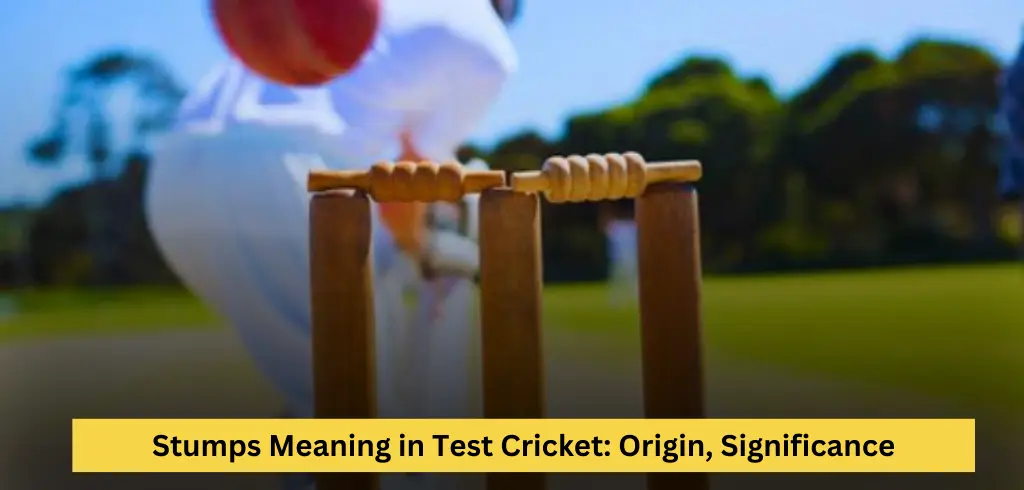The term “Stumps” is frequently heard in Test cricket to mark the end of a day’s play. But did you know the word has multiple meanings in cricket? From equipment used on the field to an essential mode of dismissal and a signal to stop play for the day, stumps holds a special place in cricket’s rich history.
In this article, we explore the meaning, origin, and importance of “Stumps” in Test cricket, including the latest practices and historical anecdotes.
What is Stumps in Test Cricket?
The term Stumps in cricket has three distinct meanings:
- Part of the Wicket:
Stumps are the three vertical wooden poles that form the wicket and support the two bails on top. - Mode of Dismissal:
A batter can be dismissed stumped when the wicketkeeper removes the bails while they are out of their crease. - End of Day’s Play:
Umpires call stumps at the end of a day’s play, signifying no further play until the next session.
Origin of the Term “Stumps”
Historically, after the final delivery of the day, umpires used to draw out the stumps (wickets) from the ground to signify the end of play. This practice gave rise to the term “Stumps” as a signal for cessation.
Read Also:- Test Cricket Rules and Regulations 2024-25
Modern Practice
In contemporary cricket, instead of uprooting the stumps, umpires remove the bails from the stumps to mark the end of the day’s play. This aligns with MCC Law 12.2:
“The bowler’s end umpire shall call Time, when the ball is dead, at the end of any session of play or as required by the Laws.”
Significance of Stumps in Test Cricket
| Aspect | Explanation |
|---|---|
| Equipment | Three stumps: Off Stump, Middle Stump, and Leg Stump, each 28 inches tall. |
| Dismissals | Stumps are crucial for bowled, run-out, and stumping dismissals. |
| End of Play Signal | Umpires signal the end of a day’s play by removing the bails from the stumps. |
The Role of Stumps in Test Matches
Stumps as Essential Equipment
In Test cricket, stumps form the core of the wicket. Each wicket includes:
- Off Stump: The stump closest to the batter’s bat.
- Middle Stump: The center stump.
- Leg Stump: The stump on the batter’s leg-side.
The standard height of stumps is 28 inches (71.1 cm), and their diameter ranges from 1.38 to 1.5 inches (3.49-3.81 cm).
End of Day’s Play: Calling Stumps
In Test cricket’s longest format, a day is divided into three sessions. After the final delivery of the day, the umpire at the bowler’s end announces “Stumps”, officially signaling the end of play.
- Historical Practice: The stumps were pulled out of the ground.
- Modern Practice: Umpires remove the bails while keeping the stumps intact.
This practice has evolved for convenience, as modern-day matches require quicker turnarounds.
Read Also:- Tea Break in Test Cricket
Latest Example: India vs Sri Lanka Test
Recently, during a Test match in Mohali, bad light forced the umpires to call “Stumps” early on Day 2. India, riding on stellar performances by Ravindra Jadeja and Rishabh Pant, dominated the day before stumps were called.
Similarly, Pakistan declared their innings at 476-4, and stumps were called with just one over of Australia’s innings bowled due to bad light in Rawalpindi.
Stumps and Modern Technology
Today, stumps are no longer just wooden poles. Advanced LED stumps and Zing Bails are used in T20 leagues and Test matches for better visibility. Modern stumps may include:
- Microphones to capture on-field sounds.
- Stump-cams for unique viewing angles.
These enhancements improve the viewing experience for fans worldwide.
The term “Stumps” in Test cricket carries historical significance and remains central to the sport. Whether as vital equipment, a mode of dismissal, or the official signal for the end of play, stumps play an irreplaceable role.
As cricket evolves, the humble stumps continue to bridge the gap between tradition and modern technology, ensuring they remain at the heart of the game.




